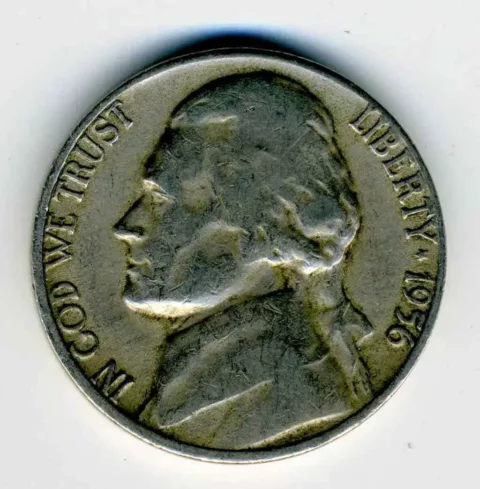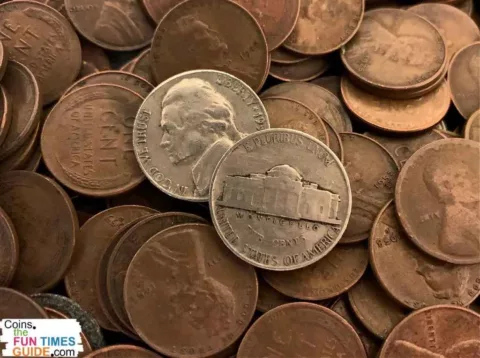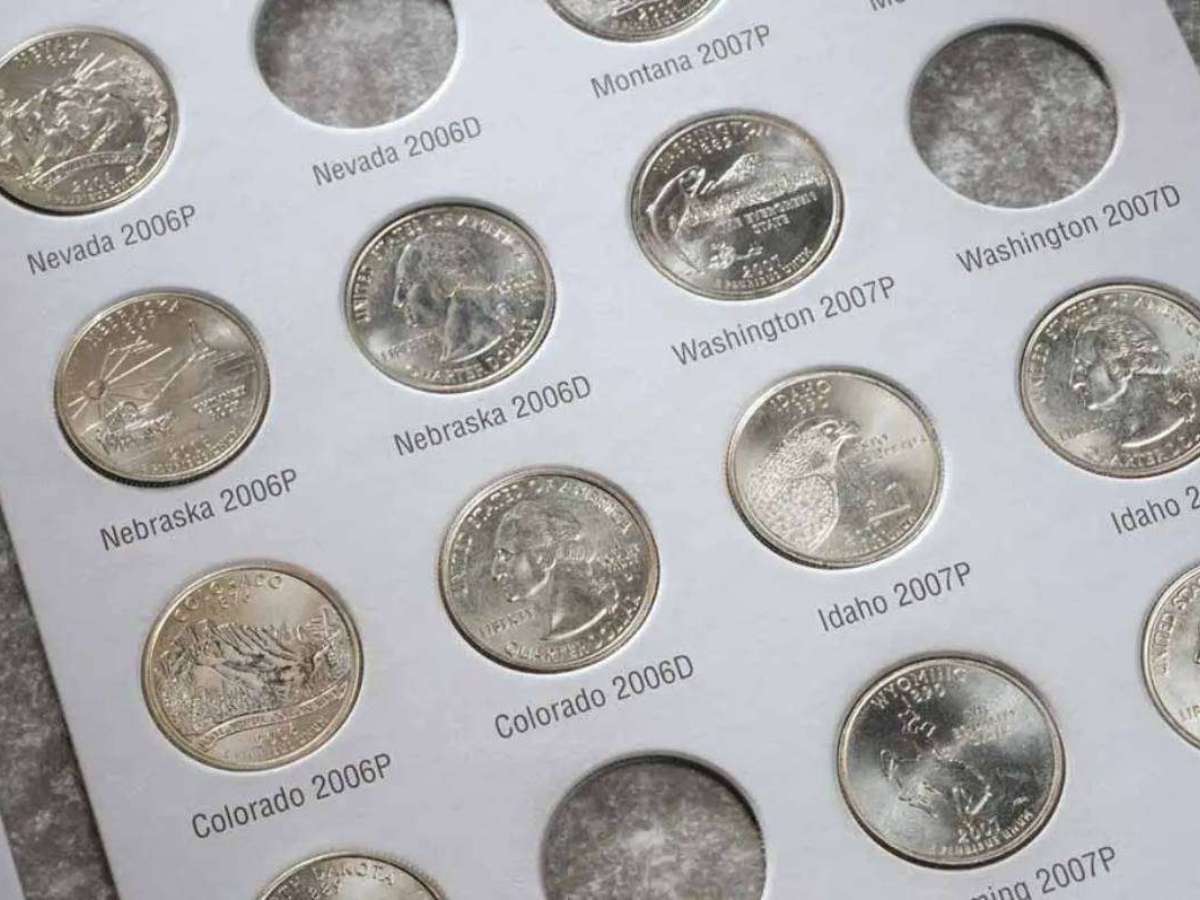
Have some 1956 nickels? Curious about what they’re worth?
While all old nickels like the 1956 Jefferson nickel are worth more than face value, some are worth hundreds dollars or even more!
Here’s how to determine the value of your 1956 nickel…
How Much Is A 1956 Nickel Worth?
Generally speaking, the better condition your coin is in, the more it’s worth.
There are 3 distinct types of 1956 nickels that each have different values.
Here’s how much your 1956 nickel is worth…
#1 – 1956 No Mintmark Nickel Value
All 1956 nickels that were struck at the Philadelphia Mint do not have a mintmark — which is totally normal.
A total of 35,216,000 Jefferson nickels were made at the Philadelphia Mint in 1956, making them quite common. This is true even considering the fact that most of these coins have since been worn, damaged, destroyed, or otherwise lost to the hands of time.
A typical 1956 no mintmark nickel in circulated condition is worth more than its face value — about 7 to 15 cents.
Most uncirculated specimens are worth anywhere from 30 cents to $1.
The most valuable 1956 nickel with no mintmark sold for $9,400 in 2015 and was graded MS-67 Full Steps by Professional Coin Grading Service.
#2 – 1956-D Nickel Value
The 1956-D nickel is the most common of the various nickels struck by the United States Mint that year — a total of 67,222,940 were made.
These coins have a “D” mintmark on the reverse (tail’s side) of the coin — on the right side of the Monticello building near the rim,
Most worn 1956-D nickels are worth 7 to 10 cents each.
The majority of uncirculated 1956-D nickels fetch anywhere from 30 cents to $1 apiece.
The most valuable 1956-D nickel was graded MS-66+ Full Steps by Professional Coin Grading Service and sold for $7,200 at a 2020 auction.
#3 – 1956 Proof Nickel Value
The United States Mint in Philadelphia struck a limited number of special 1956 nickels just for coin collectors. These 1956 proof nickels were struck by specially prepared dies on polished blanks and have a superior strike and mirror-like finish.
A total of 669,384 proof 1956 nickels were struck. And while that’s a much smaller number than either the circulation-strike 1956 no mintmark nickels or 1956-D nickels, the proof coins weren’t distributed into circulation.
While somewhat scarce, they are still widely available for collectors.
Most 1956 proof nickels trade for $3 to $5 each.
The record price for a 1956 proof nickel goes to a specimen that was graded Proof-68 Deep Cameo by Professional Coin Grading Service. It sold for $7,763 in 2011.
IMPORTANT: What Is The Grade Of Your 1956 Nickel?
To determine the true value of your 1956 Jefferson nickel, you first need to know what condition (or grade) your coin is in.
Grab a coin magnifier and a copy of the U.S. Coin Grading Standards book. Then, watch this video to see how to grade coins yourself at home:
These coin grading apps make grading coins yourself SO much easier!
A List Of Rare & Valuable 1956 Nickel Errors

On your quest to find valuable 1956 nickels, you’ve surely stumbled upon some that just don’t look right. Maybe they’ve got some weird-looking grooves, dents, or other oddities. Perhaps the rim looks extra fat or there seems to be doubling on both sides of the coin.
Unfortunately, everything just listed in the previous two sentences are forms of post-mint damage and those types of coins aren’t errors.
But that doesn’t mean every strange-looking coin is worthless. In fact, there are many valuable error coins out there and plenty of 1956 nickel errors that are worth looking for.
Here’s a rundown on some of these rare and valuable 1956 nickel errors…
1956 Doubled Die Nickel Error
Doubled die coins seem to be the big prize that everyone is looking for. Understandably, a lot of collectors (especially newbies) who spot any sign of doubling on their coins believe they have a doubled die. In virtually every case, the doubling is just mechanical doubling — which isn’t really worth anything extra.
And, in the case of 1956 doubled die nickels, there simply aren’t any major ones you can find. Unlike some years, which saw some pretty significant doubled dies roll off the presses, there are no 1956 nickels with super-valuable drastic doubling.
That doesn’t mean there aren’t some minor 1956 doubled dies out there.
Two of the best places to spot a doubled die on Jefferson nickels are:
- In the president’s eye on the obverse (head’s side)
- In the inscriptions “MONTICELLO” and “FIVE CENTS” on the reverse side of the coin
It’s possible to find doubling in other places on 1956 nickels, too!
Minor doubled dies on 1956 nickels may range in price from $10 to $25 — depending on the individual coin’s condition and magnitude of the doubled die.
1956 Off-Center Nickel Error
Off-center coins are visually striking (no pun intended) — and they’re often worth a pretty penny, to boot. These errors occur when the coin either wasn’t properly centered on the dies or the dies were misaligned.
Any degree that a coin’s markings are off-center is a legit error. However, off-center strikes that are just 1% or 2% askew are pretty common and don’t really bring any premium.
Values start to climb when a coin is around 5% off-center. And pieces that are approximately 50% off-center yet still show a complete date and (if applicable) mintmark are worth huge premiums.
A 1956 off-center nickel may range in value from about $5 for an example that’s 3% to 5% to more than $150 for a specimen 50% off-center and showing its date.
1956 Die Break / Die Cud Nickel Error
Die breaks and die cuds are all signs of wear and tear on the dies that strike a coin. As dies begin to fail, they sometimes start cracking, and these cracks appear on a struck coin as raised lines and bumps. Usually the greater the breaks and ridges are, the more a coin is worth.
One of the interesting things about die breaks is that they can appear on any coin — including your 1956 nickel. Due to the progressive nature of die breaks from one coin to the next successive piece, it’s often the case that no two die breaks from two consecutively produced coins are exactly alike.
Minor die breaks with lines, squiggles, and other signs of cracking in obscure places are sometimes worth only a tiny premium over “normal” values for the coin. Significant die breaks, particularly those with cracks transferring across the entire face of a coin, can bring much better values.
One of the most valuable types of die cracks is the cud — which is a large, flattish type of die break attached to the rim of a coin. These can bring prices well over $100.
1956 Repunched Mintmark Nickel Error
Back in the 1950s, U.S. Mint coiners applied mintmarks to each working die by hand — and this led to some interesting errors. For example, some mintmarks are in the incorrect position, wobbling to one side or another, double or triple struck, and on and on and on.
Repunched mintmarks are rather common as far as error varieties go, but they’re still highly collectible — these coins should be kept instead of spent.
Many repunched mintmarks show just a slight trace of the previous mintmark punch — something that requires magnification to see. But it’s an error nonetheless and definitely worth keeping!
The typical 1956 nickel with a repunched mintmark is worth $5 to $10.




